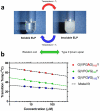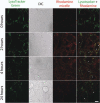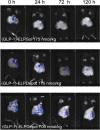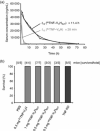Elastin-like polypeptides: Therapeutic applications for an emerging class of nanomedicines
- PMID: 26578439
- PMCID: PMC5767577
- DOI: 10.1016/j.jconrel.2015.11.010
Elastin-like polypeptides: Therapeutic applications for an emerging class of nanomedicines
Abstract
Elastin-like polypeptides (ELPs) constitute a genetically engineered class of 'protein polymers' derived from human tropoelastin. They exhibit a reversible phase separation whereby samples remain soluble below a transition temperature (Tt) but form amorphous coacervates above Tt. Their phase behavior has many possible applications in purification, sensing, activation, and nanoassembly. As humanized polypeptides, they are non-immunogenic, substrates for proteolytic biodegradation, and can be decorated with pharmacologically active peptides, proteins, and small molecules. Recombinant synthesis additionally allows precise control over ELP architecture and molecular weight, resulting in protein polymers with uniform physicochemical properties suited to the design of multifunctional biologics. As such, ELPs have been employed for various uses including as anti-cancer agents, ocular drug delivery vehicles, and protein trafficking modulators. This review aims to offer the reader a catalogue of ELPs, their various applications, and potential for commercialization across a broad spectrum of fields.
Keywords: Biomedical engineering; Drug delivery; Elastin-like polypeptides; Nanomedicine.
Copyright © 2015. Published by Elsevier B.V.
Figures







Similar articles
-
Elastin-like polypeptides: A strategic fusion partner for biologics.Biotechnol Bioeng. 2016 Aug;113(8):1617-27. doi: 10.1002/bit.25998. Epub 2016 Jun 3. Biotechnol Bioeng. 2016. PMID: 27111242 Review.
-
Drug delivery to solid tumors by elastin-like polypeptides.Adv Drug Deliv Rev. 2010 Dec 30;62(15):1456-67. doi: 10.1016/j.addr.2010.05.004. Epub 2010 May 27. Adv Drug Deliv Rev. 2010. PMID: 20546809 Free PMC article. Review.
-
Elastin-like polypeptides and their applications in anticancer drug delivery systems: a review.Drug Deliv. 2015 Feb;22(2):156-67. doi: 10.3109/10717544.2013.853210. Epub 2013 Nov 12. Drug Deliv. 2015. PMID: 24215207 Review.
-
Elastin-like polypeptide-based micelles as a promising platform in nanomedicine.J Control Release. 2023 Jan;353:713-726. doi: 10.1016/j.jconrel.2022.12.033. Epub 2022 Dec 15. J Control Release. 2023. PMID: 36526018 Review.
-
Genetically Encoded Elastin-Like Polypeptides for Drug Delivery.Adv Healthc Mater. 2021 Jul;10(13):e2100209. doi: 10.1002/adhm.202100209. Epub 2021 Jun 3. Adv Healthc Mater. 2021. PMID: 34080796 Review.
Cited by
-
The Use of Polymer Blends in the Treatment of Ocular Diseases.Pharmaceutics. 2022 Jul 7;14(7):1431. doi: 10.3390/pharmaceutics14071431. Pharmaceutics. 2022. PMID: 35890326 Free PMC article. Review.
-
Intralacrimal Sustained Delivery of Rapamycin Shows Therapeutic Effects without Systemic Toxicity in a Mouse Model of Autoimmune Dacryoadenitis Characteristic of Sjögren's Syndrome.Biomacromolecules. 2021 Mar 8;22(3):1102-1114. doi: 10.1021/acs.biomac.0c01468. Epub 2020 Dec 27. Biomacromolecules. 2021. PMID: 33356170 Free PMC article.
-
Exploring LCST- and UCST-like Behavior of Branched Molecules Bearing Repeat Units of Elastin-like Peptides as Side Components.Biomacromolecules. 2024 Nov 11;25(11):7156-7166. doi: 10.1021/acs.biomac.4c00751. Epub 2024 Oct 9. Biomacromolecules. 2024. PMID: 39383337 Free PMC article.
-
Smart Poly(N-isopropylacrylamide)-Based Hydrogels: A Tour D'horizon of Biomedical Applications.Gels. 2025 Mar 15;11(3):207. doi: 10.3390/gels11030207. Gels. 2025. PMID: 40136912 Free PMC article. Review.
-
Injectables and Depots to Prolong Drug Action of Proteins and Peptides.Pharmaceutics. 2020 Oct 21;12(10):999. doi: 10.3390/pharmaceutics12100999. Pharmaceutics. 2020. PMID: 33096803 Free PMC article. Review.
References
-
- Strebhardt K, Ullrich A. Paul Ehrlich's magic bullet concept: 100 years of progress. Nat Rev Cancer. 2008;8:473–480. - PubMed
-
- Hoffman AS. The origins and evolution of “controlled” drug delivery systems. Journal of Controlled Release. 2008;132:153–163. - PubMed
-
- Cho K, Wang X, Nie S, Chen Z, Shin DM. Therapeutic Nanoparticles for Drug Delivery in Cancer. Clinical Cancer Research. 2008;14:1310–1316. - PubMed
-
- Greish K. Enhanced permeability and retention of macromolecular drugs in solid tumors: A royal gate for targeted anticancer nanomedicines. Journal of Drug Targeting. 2007;15:457–464. - PubMed
-
- Sharom FJ. The P-glycoprotein efflux pump: how does it transport drugs? The Journal of membrane biology. 1997;160:161–175. - PubMed
Publication types
MeSH terms
Substances
Grants and funding
LinkOut - more resources
Full Text Sources
Other Literature Sources
Research Materials

